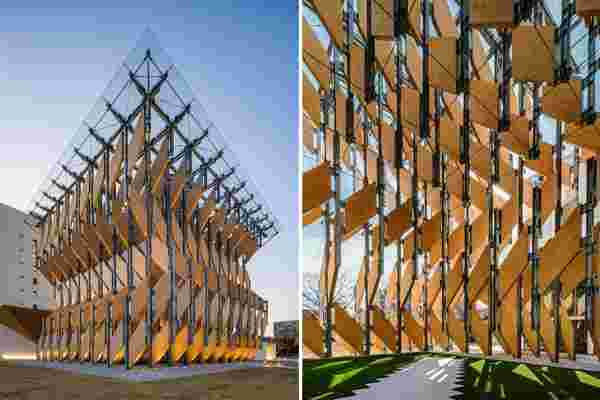
In the heart of Harumi, Japan, Kengo Kuma and Associates (KKAA), an architecture firm based in Japan, have designed a semi-open and temporarily placed pavilion for art performances, events, and showcases that will be deconstructed and repurposed in the future for another pavilion located in Hiruzen National Park of Japan’s Okayama Prefecture. Similar to the mountain’s summit in Hiruzen, Kengo Kuma’s pavilion was built and layered in such a way that depicts a melding of both the shoulder of a rocky mountain and a greenhouse drenched in sunlight.
The designers behind Harumi’s temporary pavilion used a steel frame as the structure’s base, over which CLT panels were overlaid to create a multi-paneled facade that spirals and crests towards the open sky. CLT panels, or Cross-Laminated Timber, are appealing for their prefabricated, lightweight yet durable quality and their neat installation process which has a low overall environmental impact. While the CLT panels form a zig-zag pattern and overlap one another from their orthogonal gluing process, exposed gaps of open-air needed covering. Preparing for fits of bad weather, KKAA bordered the gaps of air with transparent pieces of copolymer film called, TEFKA. On the reasoning behind choosing TEFKA to board up the pavilion, Dr. Kengo Kuma said that the weather-resistant film, “is lighter than glass and so pliable as to be rolled to transport it. It is [the] ideal material for relocation and reconstruction. It also has the perfect transparency we have sought.”
By implementing clear, glass-like plastic film to maintain a closed space within the pavilion, while maintaining the zig-zag pattern of the CLT patterns, shadows of sunlight turn this public pavilion into a glittering forest maze during peak sunlight hours. Additionally, inside the interior exhibition, odes to the natural world and forestry run rampant. In rooms like, “The Forest Room,” tornado-like, crossed panels of timber resemble the monolithic vigor and longevity of wooded forests. The CLT panels were made and provided by Meiken Lamwood Corporation in Maniwa, using timber from Japanese Cypress trees, obtained from Japan’s Okayama Prefecture, where the team at Kengo Kuma plan on relocating their semi-open-air pavilion. From the materials used to build this communal, natural space to the upcoming big move back to the CLT Park’s roots all work together in reminding us of how close we remain to the natural world and of the inevitable journey back for each of us.
Designer: Kengo Kuma and Associates
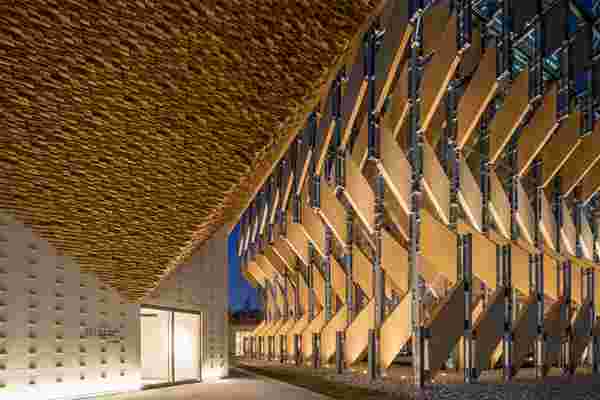
This spaceship from the 1960s was restored for guests to stay for some Jetsons-inspired staycation!
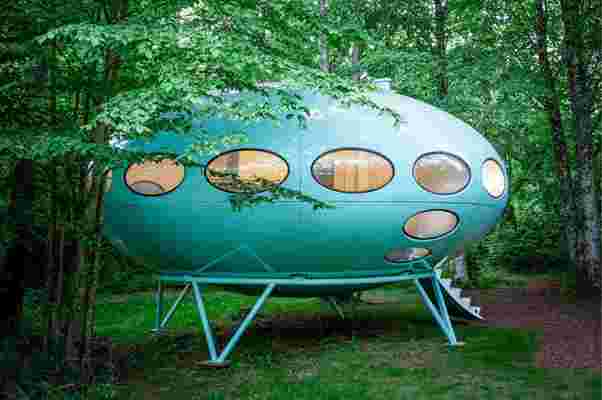
Nowadays, our gaze is set on outer space. Modern times feel eerily similar to the thrill of the days during the 20th-century Space Race. While the goals of the Space Race change over time, our interest in the starry sky remains. On earth, we watch films like The Jetsons and marvel at Elon Musk’s Starlink, if only because it looks like a moving constellation, just to feel closer to Outer Space. Today, artist Craig Barnes restored a saucer-shaped structure , designed by Finnish architect Matti Suuronen in the late 1960s, calling it Futuro House in his ode to the cosmos.
Landed in Somerset’s Marston Park for guests to rent out, stay the night, and pretend they’ve landed on Mars, the Futuro House is a tiny home can accommodate up to four people and features an array of earthly amenities. Barnes happened upon one of Suuronen’s 68 saucer-shaped structures while out in South Africa, bringing it back to the UK, where he began restoration work.
Easily transportable, Barnes describes how he managed to bring Futuro House to Somerset, “Some workers were knocking down a building nearby and we thought perhaps they were going to tear it down too. It was a wreck, there was no front door left, the windows were smashed in, but they let us in. It was horrible and grotty, but we found out who owned it. On an impulse while on top of Table Mountain, we agreed to buy it. So we bought it and shipped it home.”
Sparing Suuronen’s retrofitted relic from a future spent in obsolescence, Barnes restored Futuro House into a sparkling ski lodge, allowing guests to stay the night for £400–£1,200 ( around $550–$1,412) per night, a rent scale depending on the number of adults staying inside the ship. Inside and outside the saucer, guests can enjoy plenty of onboard amenities, like private bathrooms, fresh linen, and towels, hot water, changeable mood lighting, midrange studio monitor speakers, food services, options for coffee and tea, as well as an outdoor fire pit where guests can sit around and recline into the night. Going on to note his thrill over his own interpretation of today’s Space Race, Barnes says,
“It was always important to me that wherever it goes, it functions as a space to live and experience – an inspiring place that everyone can see. I never wanted this to be something that you cannot touch. I believe in the power of art and architecture and how it affects us. We have never opened [the house] up as a rental before; we hadn’t found the right home for it. At Marston Park, they want to make unique experiences and there is a realm for artworks you can stay in and people are interested in that. It is the fulfillment of a longstanding dream to offer this womb-like structure for people to stay in and be in this otherworldly space.”
Designers: Chris Barnes x Matti Suuronen
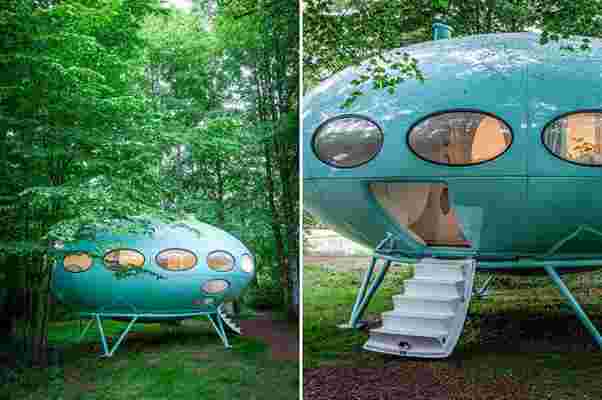
Stationed beside a quiet lake amongst the trees of Somerset’s Marston Park, Futuro House appears as a UFO landed for a pitstop.
Inside, the 60s space themes continue with spaceship seating arrangements and oval-shaped windows that wrap the entire circumference of the saucer.
Tulip kitchen seats hearken back to the 60s when the Space Race reached a peak.
While there is only one main sleeping area, four people can stay the night.
Come dark, the spaceship glows into a golden lantern.
While on a midnight stroll in the park, onlookers could even mistake Futuro House for a real UFO.
Stationed against orange night skies, guests can pretend they’ve landed on Mars.
Breathtaking residential building in Mexico comes with its own vertical forest and solar panels on its terrace
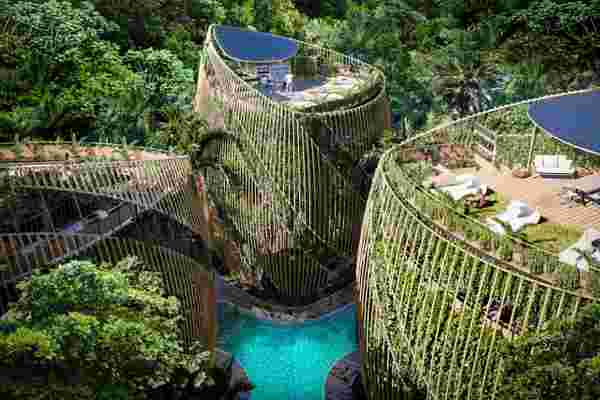
Living The Noom’s design is everything you want from a building – an unusually beautiful organic structure, covered with a lush tone of green brought about by the vertical forests running along its surface, and running almost entirely on renewable energy.
Designed by Mexico-based Sanzpont Arquitectura, ‘Living In The Noom’ puts you in the lap of nature and luxury. Its sanctuary-esque design focuses on three broad pillars – Wellness, Sustainability, and Flexibility. The community features multiple 4-storeyed houses with a uniquely alluring triangular shape, characterized by vertical bamboo channels and a vertical forest growing on the outer facade of the building. Finally, the structure culminates in a terrace on the fifth floor that has solar panels for harvesting energy, and an urban garden where the residents can grow their own food.
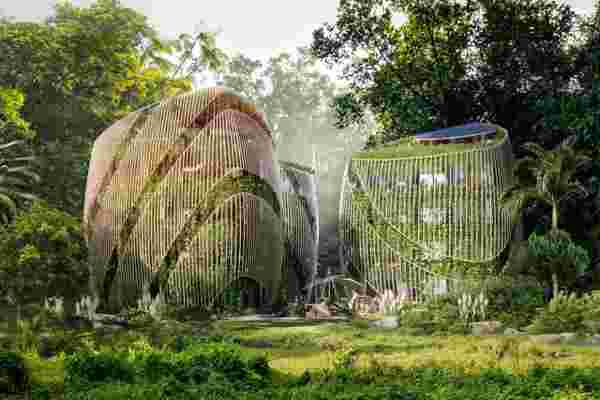
A winner of multiple architecture awards, the Noom project focuses on creating a community for people that focuses on their individual needs. This meant visualizing the entire project as something multi-faceted, rather than a building made of boxes that simply ‘contained’ their occupants. Aside from giving Noom’s residents a stellar home to live in, the project even comes with amenities like greenery (70% of the project’s area is covered in nature – the buildings occupy just 30% of the overall space), as well as rejuvenation centers, meditation areas, parks, pools, workshop-centers for art, and even the organic garden for healthy eating.
The project integrates bioclimatic and sustainable strategies such as rainwater harvesting, wastewater separation, wetland for greywater treatment, biodigesters, compost area, and more notably the vertical forest on the outside of each building, which aside from providing a touch of greenery, also filters/purifies the air coming through into the house, and helps reduce the temperature of homes – a phenomenon more commonly known as the Heat Island Effect.
The overall Noom community comprises 3 buildings of 5 stories each. The apartments on each floor are 120 and 60 square meters, having 1, 2, or 3 bedrooms. The unique layout allows each room to have access to ample indirect sunlight. The design of the house also promotes natural ventilation to renew the indoor air and ensure an optimal level of comfort. The architects at Sanzpont say that their unique layout helps reduce energy consumption (lights and air conditioning) by as much as 85%. For the rest, solar panels on the roof and a high-efficiency LED artificial lighting system helps power the buildings at night.
‘Living In The Noom’ is a Platinum Winner of the A’ Design Award for the year 2021.
Designers: Sanzpont Arquitectura and Pedrajo Mas Pedrajo Arquitectos








